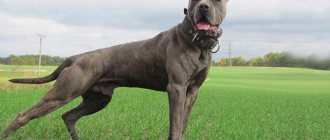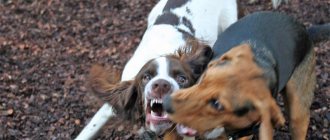Fear is a natural survival mechanism necessary for each of us. It is typical not only for people, but also for four-legged pets. There is nothing wrong with periodic fear if it is associated with an unusual environment or new acquaintances.
Behavior correction is only needed when the animal is afraid of everything or too often. In such a situation, you need to figure out as soon as possible what your dog is most afraid of and how to overcome his fear.
Fear of Thunder
Astraphobia, the fear of thunder, is very common in dogs. The degree of this fear may vary from dog to dog. Some may just be slightly afraid of thunder.
In this case, the dog may shake slightly or you may notice flattened ears, wide eyes, and an erect tail during a thunderstorm. Other dogs may have a more severe phobia that causes them to hide, become destructive, or even lose bowel or bladder control.
Dogs with astraphobia may or may not be afraid of other loud noises. Many dogs suffer from a general phobia of noise. They get scared when they hear thunder, fireworks, loud music, trucks driving down the road, etc.
Fear of walking or being outside
Walking on the street frightens you with unusual sounds. Experience is also required here. During a fright, do not follow your pet's lead. Try to walk not only in closed courtyards, but also near a noisy road. Over time, the dog will get used to the stimuli and stop experiencing stress.
Don't forget the leash. At first it will be especially useful, since without it a panicked pet may get hit by a car.
Fear of fireworks
Another common dog phobia is the fear of fireworks. Similar to fear of thunderstorms, the loud and unpredictable sounds and lighting effects of fireworks cause many dogs to tremble in fear. This fear can even cause a dog to run away and get lost.
For some dogs, gradually becoming accustomed to the sound of fireworks can eliminate the phobia. In other cases, management techniques may be required. Dogs with severe fireworks phobia may require treatment with anti-anxiety or sedative medications.
Fear of thunderstorms and fireworks
Fear of thunderstorms and fireworks is the most common fear due to the combination of loud sounds and bright flashes of light. Both are associated with danger and take you by surprise.
While walking
If your pet gets scared on the street, pull on the leash and command “Nearby.” Stay calm and ignore the fear. Otherwise, your emotions will only increase your concerns.
While at home
Follow a similar pattern at home. Don't panic and try to distract your pet. Close all windows, turn on quiet music and divert the four-legged attention to following commands or playing together.
Fear of being alone (separation anxiety)
The fear of being left at home alone is called separation anxiety. Dogs suffering from separation anxiety tend to exhibit destructive behavior as soon as their owners leave the house.
Other symptoms include excessive barking and home invasion accidents when left alone.
Changing a dog owner's behavior can help ease his dog's fears. By simply changing their habits before leaving the house and remaining composed when they leave and return home, dog owners can reduce their dog's anxiety a little.
Desensitization, the process of gradually getting a dog used to being left alone at home, can also be helpful for dogs suffering from separation anxiety.
Sometimes it can also help to train the dog to stay in the crate while the owner is away. If separation anxiety is severe, the animal may sometimes need to be treated.
The only way to avoid trouble is to not make a mistake when choosing a puppy.
Chat with the breeder. If he has nothing to hide, he will kindly answer all your questions, show his parents and conditions. Defects of the nervous system are transmitted genetically, so observe the behavior of the mother of the puppies.
One way to test temperament is through tests.
- Check your babies' reaction to noise. For example, the sound of keys falling. The “correct” puppy may be scared, but he will quickly adapt and go to see what is lying there.
- Try taking the baby to another room or outside if you have a fenced yard. See how he will behave without his brothers, sisters and mother. Bring a toy or some object. Observe the reaction.
- The baby should not bark, hide or just sit. A normal puppy is friendly and moderately curious. Of course, everyone is individual, but some reactions go beyond the norm.
Many choose the most timid and unfortunate one, because it becomes pitiful. Are you absolutely sure that you can cope with such a test? If yes, then let's find out what to prepare for.
Fear of the vet
Dogs are often afraid to go to the vet. A dog's first encounter with a veterinarian usually involves strange smells, new handling, restraint, and vaccinations. It's no surprise that dogs can be easily afraid of going to the vet.
If there are no other phobias, fear of the veterinarian can be overcome by simply taking the dog to the veterinarian for a few social, non-exam visits. Give praise and treats if your dog remains calm.
Not to cure, but to alleviate: 7 ways to help a dog that is afraid
The choice of correction method, as well as the time required to solve the problem, depend on the intensity of the fear. Mild anxiety can often be dealt with in a few days by simply changing the format of walks, but fighting a severe phobia often takes many months of painstaking work. Some fears, unfortunately, can never be overcome.
Understanding the cause of the dog’s anxiety is, of course, much easier to work with than wandering in the dark, selecting a solution by touch. It is not without reason that experts unanimously say that for successful correction, a thorough “debriefing” with observation of the actions of both the dog and the owner is important.
There is no magic universal cure that can permanently rid a dog of fear and anxiety. For example, a dog is afraid of a person leaving. Was she scared by the neighbors who were doing renovations, or was it due to insufficient socialization? In one case, relaxing “dog” music can help (yes, there is such a thing), but in another it will not be possible without long-term desensitization, perhaps even with the use of pharmacology.
Obviously, the best solution would be to consult a specialist. But is it possible to do without the help of a dog handler and try to cope with the phobia on your own? Yes, of course: there are proven techniques, the use of which often helps to alleviate the dog’s feelings and does not cause harm if used ineptly. Give it a try. The main thing is to know when to stop.
Exercise stress
Exercise is one of the easiest and most accessible ways to help a dog experiencing chronic stress. Photo: thecollienois.com
High-impact exercise is a great stress reliever for both humans and dogs. Such work in the context of fear therapy allows you to kill several birds with one stone.
First, physical exercise stimulates the production of serotonin, the so-called “happy hormone.” According to scientists, the body receives a portion of this hormone “as a reward” for the hard work done. Secondly, they relieve the dog of pent-up energy and excess tension that can worsen anxiety.
Burning off a dog's excess energy every day with long walks, Frisbee play, or jogging next to a bike can significantly reduce the severity of problems such as separation anxiety or moving stress. It is not without reason that they say that a good dog is a tired dog.
Abstraction
When it comes to treating fear of loud noises or fear of large crowds of people, distraction as a correction method can sometimes work wonders. Engaging your dog's brain in interesting activities helps him focus on familiar and understandable things, rather than on the unknown, frightening world around him.
Dealing with distraction involves several well-practiced skills learned using positive reinforcement. It’s wonderful if a dog can perform interesting tricks: they, as a rule, carry a powerful positive charge. No, “ordinary” commands will also work, the main thing is that their implementation is sincerely and generously rewarded.
But distraction is not a matter of command alone: highly motivated, gambling dogs can be distracted by an interesting toy, such as a favorite ball or a tug of war, designed for food - an incredibly tasty delicacy.
If you want, you can almost always find something that will attract the dog's attention more than noise or crowds of people, something that will help him associate scary objects or events with interesting or high-value rewards. Then the event will gradually move from the category of “frightening” to at least “tolerable”.
Anti-stress vest
Originally called a thundershirt, we know it as an anti-stress or calming vest. Photo luckypet.com.au
Recently, anti-stress vests have become an increasingly popular solution for treating anxiety in dogs. It is a type of tight-fitting blanket that is wrapped tightly around your dog's body in times of extreme stress. The idea is that the feeling of constant pressure can help calm the nerves of a dog who, for example, is afraid of traveling or loud noises.
At the moment there is no strong evidence of the effectiveness of this method. Some dog owners who have tried it talk about its wonderful properties, others note with regret that they did not receive anything significant.
Apparently, the effectiveness of a thundershirt depends largely on when and how it is used, and on the personality of the individual dog. Its use can be recommended as part of complex therapy for serious fears to possibly increase the effectiveness of other methods.
Relaxing massage
Yes, massage is a great way to calm your dog's nerves. No, you don't need a massage table for this. Photo petlabadvisor.com
It's not just people who love a good massage: many pets also don't mind soothing their nerves in such a pleasant way. But seriously, gentle massage with slow, long strokes can really help calm an anxious dog.
One of the most popular dog massage techniques, called T-Touch, was created by Linda Tellington-Jones. It is based on circular movements of the fingers and hands throughout the body. The purpose of T-Touch, according to the author, is to activate cellular function and awaken cellular intelligence, thereby effectively relaxing the dog.
Whether this is true or not remains on the conscience of the author of the method. Of course it's different: studies have shown that stroking a dog or cat can help normalize blood pressure and calm a person's nerves, so massaging a dog is a win-win solution in any case.
Use of pheromones
Scientists believe that certain smells can help relieve a dog's anxiety. The synthetic chemicals used for this purpose imitate the smell of special hormones called pheromones, which are produced by the body of a lactating bitch. These hormones help puppies relax and feel at peace, and create lasting positive associations with their mother.
The problem is that at the moment there is not enough data confirming the calming effect of pheromones on the behavior of adult dogs experiencing anxiety or fear: the studies conducted only concerned the perception of these odors by puppies.
However, there is still a possibility of a positive effect of pheromones, and therefore their use can also be recommended as one of the methods in the complex treatment of anxiety and fears in some dogs.
Soothing music
Music can really have a calming effect on anxious dogs. Photo gopetplan.com
As in the case of massage, people are not the only living beings whose bodies are able to respond to the effects of certain sounds. It's no secret that many owners leave the TV or radio on when leaving home, thus trying to help the dog feel more comfortable.
As it turns out, there are special music selections that their authors believe can help especially anxious dogs survive periods of extreme stress. They state: “The psychoacoustic information that is redundant from the dog's point of view is converted into simple sound. What this means is that we minimize the complex auditory information contained in most music and make it understandable to dogs.”
Music intended for dogs is not only specially selected, but also arranged in a special way, which makes it as easy as possible for the animal’s brain to perceive it. The authors say it can help treat a range of fears, such as separation anxiety or travel anxiety. There are even collections designed to desensitize dogs with phobias of loud noises.
Homeopathic remedies and dietary supplements
In the context of helping dogs suffering from one kind of phobia or another, one cannot fail to mention homeopathic sedatives and dietary supplements designed to maintain the animal’s nervous system in optimal condition. Naturally, we are not talking about “heavy” medications that are sold exclusively with a doctor’s prescription: these are primarily vitamin-mineral complexes and herbal preparations, similar to Doctor Bach’s preparations.
Although the effectiveness of homeopathy has been questioned by many, and has recently even been officially removed from the category of “medicines,” the use of such drugs can also be part of an overall strategy for addressing the problem of fears in dogs.
Naturally, it should be noted that any drugs may have contraindications and before using them it is imperative to consult a specialist.
Liked? Subscribe to my YandexZen channel and see pictures on Instagram.
© 2019-2022 Alexander Smirnov @kinologsmirnov.ru. Respect the work of the author: copying any part of the material is possible only with indication of authorship and a link to the source.
Fear of driving in a car
Some dogs are afraid to ride in cars. This fear often stems from not having driven a car before. It can also develop after a negative experience in a car, such as when she got sick and drove in the car to stay at the shelter, or simply drove in the car to go to the vet.
You can overcome your dog's fear of riding in the car by using treats and praise to slowly lure your dog into the car, and then gradually build up to the ride in small steps. Make sure the destination is a happy place, such as a dog park or a walk, and not too far away.
Prohibited techniques and mistakes
The appearance of most phobias is associated with a lack of socialization and negative experiences. For this reason, try to avoid the following mistakes:
- Punishment or reward for being scared. In the first case, distrust and fear of people develops, and in the second, belief in the real danger of an event occurring or an object seen is strengthened.
- Avoid contact with other animals and people. Complete isolation is fraught with serious mental problems.
- Insufficient walking and refusal to train. The lack of new information and knowledge negatively affects behavior.
- Refusal to visit a veterinary clinic and grooming salon. Preventive examination and hygiene procedures should be routine, not a surprise.
Be patient and do not hesitate to seek professional help if difficulties arise.
Fear of going up and down stairs
A dog owner may not realize that their dog is afraid of going up and down stairs until their dog pauses as they approach the steps.
This phobia almost always occurs due to a lack of early socialization and exposure. A dog that hasn't walked on stairs in his youth may become fearful of going up and down stairs when he encounters stairs in later life.
Some dogs can overcome this fear if you make going up and down stairs a game. Other dogs may need to learn to walk up stairs literally one step at a time. This will take time and a lot of positive reinforcement.
Older dogs may be reluctant to use stairs if they have arthritis or other mobility issues, so be sure to rule out medical problems due to this behavior. If the dog has a history of bad falls from stairs, this may also be a cause of fear.
What to do if your dog is afraid of everything?
Having figured out the source and cause of the phobia, begin to correct behavior. To do this, you will need to reduce stress levels and increase your four-legged confidence.
Correcting puppy behavior
If the puppy is afraid of everything, do not force things and give him time. Work with the existing problem at a comfortable pace, without forgetting about breaks. Get used to the street gradually, focusing on your pet’s behavior:
- Ignore the fear, but do not leave the baby without support. As soon as the puppy gets scared, call him closer and gently squeeze him between your legs. This position will remind him of his mother’s warmth and reduce anxiety.
- Be sure to stop introducing the frightening object when attacks become more frequent and do not hold the puppy in place by force. Switch your attention to the game, following a command, or giving a treat.
The method that works best is to reinforce positive associations. Give your puppy a treat for every step he walks if he is afraid of stairs, or for every stranger he meets if he is afraid of people.
Adjusting the behavior of an adult animal
Changing behavior as an adult is almost impossible. Here it is better to immediately contact a dog handler, since such four-legged animals require an individual approach.
In some situations, the only way to eliminate a phobia is to take medications. You should consult your veterinarian on this matter.
Fear of men
<
People may be surprised to learn that dogs are quite often afraid of men. In some cases, this fear may be caused by violence from a man.
However, more often this is due to a lack of socialization. Dogs that haven't spent much time with men may be afraid of their deeper voices, larger frames, and even facial hair.
Dogs that are afraid of men should be gradually desensitized to men without threatening them. Keep in mind that a fearful dog may growl, snap, or bite someone due to this fear. Gently expose your dog to people at a distance. Make sure men know not to make eye contact or approach your dog. It may take time for your dog to overcome this fear.
How to train courage in your pet
We looked at the phenomena that frighten animals and understood why this happens. Now let's find out how to stop your dog from being afraid of them.
What you should never do is scold or punish the dog. This will only increase fear and can cause a real panic attack in the animal. On the other hand, gentle persuasion is also not recommended - the dog may take it as encouragement and decide that this is how he should react in the future.
To wean a dog from being afraid, in stressful situations it is important to remain completely calm. It is your behavior that will become a guide for the animal. Do not scold or console your pet, but distract him with training or play, and, if possible, reward him with a treat for following the command.
If what the dog is afraid of is actually harmless, it needs to be accustomed to this phenomenon. For example, including audio recordings with scary sounds. At first this is done at a low volume, gradually increasing it.
To teach a fearful pet to interact normally with people, you need to take him with you in company. At the same time, initially no one should pay attention to the dog, including not petting him. Later, when he feels more confident, one of the strangers may address him affectionately.
Of course, you shouldn’t make a dog fearless at the expense of the instinct of self-preservation, if his “profile” does not require it. Overcoming fear of truly dangerous things, such as fire or a stun gun, should be handled by an instructor.
Treat your pet's fears with patience and understanding, and sooner or later you will help him overcome them.
Recommended Posts
Standard height and weight of the Cane Corso breed by month
Weight of a puppy and an adult Labrador by month
Weight and height of a German Shepherd puppy by month
Description and content of the hunting border terrier
Description and care of the highly intelligent Border Collie breed
Description of forms and features of treatment of enteritis in cats
Fear of children
Dogs are afraid of children for several reasons. Most often this occurs due to insufficient early contact with children.
Many people get dogs before they become parents. If you don't bring your puppy into a home where there are children, your dog may not get the opportunity to interact with them. Try your best to introduce your dog to children of all ages, starting from puppyhood.
Dogs that are afraid of children may have had negative experiences with children. Although the child's intentions may be good, the dog may interpret attempts at affection as a threat.
Some dogs may not understand the baby's sounds, sudden, uncoordinated movements, or their small size. Dog owners who are dealing with a dog that is afraid of children should consult with a dog trainer or dog trainer to work on this phobia.
Ultrasound
What dogs are afraid of is ultrasound. Quite a long time ago whistles went on sale, but not quite ordinary ones. A person does not hear the sound that an effective repeller makes. The reason is simple: human hearing cannot tune in to the frequency of the whistle, but dogs pick it up perfectly. It acts as an irritant, which allows you to instantly calm and even scare your four-legged pet.
It is important to understand what dogs are afraid of in order to scare away an aggressive and excited animal in time. The whistle does an excellent job of this task, causing headaches and irritation in the dog. At the same time, it is not recommended to “play around” with the device, but to use it only for self-defense purposes. The whistle may not work if pointed at a sick animal. And if you decide to test the effectiveness of the device, then you do not need to test it on those dogs that behave peacefully - ultrasound can cause an attack of aggression in the dog.
Fear of certain objects
Some dogs develop a fear of a specific object: a vacuum cleaner, holiday decorations, a children's toy, construction equipment, etc. Very often this type of fear is not very difficult, since many objects can simply be moved out of sight.
However, in some cases this can be problematic. For example, if your dog refuses to walk past the statue outside your apartment building, or if he turns into a quivering, anxious mess every time you need to vacuum the carpet.
In this case, you may need to slowly and cheerfully introduce your dog to the objects he is afraid of.
Sticks
What dogs are usually afraid of is sticks. This phenomenon causes bewilderment among pet owners, because many of them have never suffered from beatings with any objects.
It is important to understand that a four-legged friend is afraid not of the fact that a stick will appear, but of the threat that arises when a person raises his hand with a large object above his head. We are not talking about those dogs that were regularly punished. It is important to understand that pets who are raised as infantile tame dogs can still be aware of danger on an instinctive level. However, just like a person. If your interlocutor suddenly waves his hand, you will involuntarily close your eyes and your heart will begin to beat treacherously. But this doesn’t mean that you are a real coward and were afraid of a simple gesture? Even if you were not exposed to cruelty or violence as a child, a raised hand will still make you worry for a split second. This happens on an instinctive level - just like with four-legged friends.











